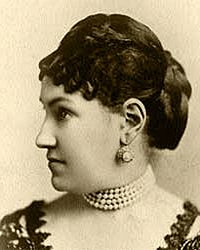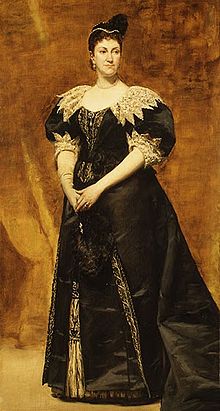- Caroline Webster Schermerhorn Astor
-
Caroline Webster Schermerhorn Astor 
Born Caroline Webster Schermerhorn
September 22, 1830
New York CityDied October 30, 1908 (aged 78) Other names The Mrs Astor Political party Republican Spouse William Backhouse Astor Jr.  Portrait of Mrs. Astor by Carolus-Duran, which was placed prominently in her house. She would stand in front of it when receiving guests for receptions.
Portrait of Mrs. Astor by Carolus-Duran, which was placed prominently in her house. She would stand in front of it when receiving guests for receptions.
Caroline Webster Schermerhorn Astor (September 22, 1830 – October 30, 1908) was a prominent American socialite of the last quarter of the 19th century. Famous for being referred to later in life as "the Mrs. Astor" or simply "Mrs. Astor", she was the wife of real estate heir William Backhouse Astor Jr. Four years after her death her son John Jacob Astor IV was the richest man on the RMS Titanic and perished in the disaster of that ship.
Contents
Childhood and youth
Caroline Webster Schermerhorn was born into New York City's Dutch aristocracy, descendants of the city's original settlers; her father, Abraham Schermerhorn, his brother and the extended Schermerhorn family were engaged in shipping. At the time of her birth, her family lived at 1 Greenwich Street, near the Bowling Green, but the population growth and increasing urbanization of lower Manhattan in the 1830s led her family to move farther north to 36 Bond Street, near the then-ultra fashionable "Lafayette Place," which had been developed by her future husband's grandfather, John Jacob Astor. Caroline married William Backhouse Astor, Jr. in 1854.
Housewife and socialite
Although popularly imagined as wholly preoccupied with "Society", for the first several decades of her married life "Lina" Astor was principally occupied with raising her five children and running her household, typical of women of her class in mid 19th century New York City. In 1862 she and her husband built a four-bay townhouse in the newly fashionable brownstone style at 350 Fifth Avenue, the present site of the Empire State Building, next door to her husband's older brother, John Jacob Astor III; the two families were next-door neighbors for 28 years although the Astor brothers did not get along.
The gatekeeper
In the decades following the Civil War the population of New York City grew almost exponentially, and immigrants and arrivistes from the Midwest began challenging the dominance of the old New York Establishment of which Lina Astor and her family were part. Her desire to be the unchallenged grande dame of New York society was as much about preserving the heritage and traditions of her native New York, a conflict dramatized by Edith Wharton in The Age of Innocence, as it was about excluding those whom she deemed inferior.
Aided by the social arbiter Ward McAllister, whose life work was the codification and maintenance of the rules of social intercourse, Lina Astor attempted to codify proper behavior and etiquette, which had formerly been a lingua franca among the city's Establishment, as well as determine who was acceptable among the arrivistes for an increasingly heterogeneous city. McAllister once stated that, amongst the vastly rich families of Gilded Age New York, there were only 400 people who could be counted as members of Fashionable Society. He did not, as is commonly written, arrive at this number based on the limitations of Mrs. Astor's New York City ballroom. (McAllister, an Astor cousin by marriage, referred to her as the "Mystic Rose".) Her husband's lack of interest, not only in the social whirl but in Lina herself and their marriage, did not stop but instead fueled her burgeoning social activities, which increased in intensity as her children grew older.
Mrs. Astor was the foremost authority on the Aristocracy of New York in the late nineteenth century. She held ornate and elaborate parties for herself and other members of the elite New York socialite crowd. None was permitted to attend these gatherings without an official calling card from Mrs. Astor herself. Mrs. Astor's social groups were dominated by strong-willed aristocratic females. These social gatherings were dependent on overly conspicuous luxury and publicity. Moreso than the gatherings themselves, importance was highly placed upon the group as the upper-crust of New York's elite. Mrs. Astor and her ladies therefore represented the Aristocratic, or the Old Money, whereas the newly wealthy Vanderbilt family would establish a new wave of New Money.[1]
Mrs. Vanderbilt, as a new member of socialite New York through the copious amounts of money that her family had earned rather than inherited, represented a type of wealth that was abhorrent to Mrs. Astor and her group. For this reason, Mrs. Astor was reluctant to call upon the Vanderbilt girls. In 1883, however, Caroline Astor was forced to formally socially acknowledge Alva Vanderbilt, the first wife of William Kissam Vanderbilt, thereby providing the Vanderbilts, the greatest "new" fortune in New York, entrance into the highest rungs of society. An oft-repeated New York legend has it that Alva Vanderbilt had planned an elaborate costume ball with entertainments given by young society figures for her housewarming, but at the last minute notified young Caroline Astor (Lina's youngest daughter) that she could not participate, because Mrs. Astor had never formally called on Mrs. Vanderbilt. Also likely, Mrs. Astor had noted the rising social profile of the Vanderbilt family, led by Alva and Willie, and viewing them as useful allies in her efforts to keep New York society exclusive had called formally on the Vanderbilts prior to Alva's lavish ball which Mrs. Astor herself attended. The Vanderbilts were subsequently invited to Mrs. Astor's annual ball, a formal acknowledgement of their full acceptance into the upper echelon of New York society.
Children
- Emily Astor (1854–1881) who married James J. Van Alen,
- Helen Schermerhorn Astor (1855–1893),
- Charlotte Augusta Astor (1858–1920),
- Caroline Schermerhorn Astor (1861–1948),
- John Jacob Astor IV (1864–1912)
Head of the family: the Waldorf-Astoria
Until 1887, Caroline Astor had been formally known as "Mrs. William Astor", but with her sister-in-law's death that year, she shortened her formal title to "Mrs. Astor", as she was then the senior Mrs. Astor, the only remaining one in her generation. Her nephew, William Waldorf Astor, felt that his wife should be technically "the Mrs. Astor", as he was the only son of Caroline's husband's elder brother, and he insisted Caroline resume use of "Mrs. William Astor". She refused, and the press sensationalized the family conflict and famously began referring to her as "The Mrs. Astor".
On the death of Caroline's brother-in-law John Jacob Astor III in 1890, William Waldorf Astor inherited his father's share of the Astor holdings and, titularly, became the head of the Astor family. His further attempts at challenging his aunt's preeminence in New York society, however, were thwarted, and he soon emigrated to Great Britain, where he later became a viscount.
William Waldorf Astor, in his absence, commissioned his mansion on Fifth Avenue and Thirty-third Street to be torn down. In retaliation for his aunt's intransigence, William Waldorf Astor had his father's house torn down and replaced by the first Waldorf Hotel. The hotel was specifically designed to overshadow Mrs. Astor's mansion which was right next door, in an attempt to overshadow her status with it. Caroline and her son, John Jacob Astor IV, first contemplated tearing down her house and replacing it with livery stables. The Waldorf Hotel was thirteen stories tall, and was built in the form of a German Renaissance chateau; and thus not only overshadowed Mrs. Astor, but all other structures in the neighborhood as well. "There's a glorified tavern next door," Mrs. Astor famously is quoted as saying. Until the opulence of the Waldorf Hotel revolutionized how New York socialized publicly, polite society didn't gather in public places, especially hotels. Unwilling to live next door to New York's latest sensation and public draw, Caroline and her son tore her house down and erected another hotel at its site, the Astoria, and soon the two hotels merged and became the original Waldorf-Astoria Hotel, which was torn down in 1928 to make way for the Empire State Building.[2]
Death, grave, and legacy
By the time she moved into her new house facing Central Park, at the corner of 65th Street, her husband had died, and she lived with her son and his family. Caroline Astor spent her last several years suffering from periodic dementia, and she died at age 78 in 1908 and was interred in the Trinity Church Cemetery located in the far northern section of Manhattan. In addition to her uptown burial plot, a commemorative 39 foot tall (11.9 m) cenotaph erected in her memory by her daughter Caroline Astor Wilson (according to the inscription dated A.D. MDMXIV) is located within the small churchyard cemetery at the intersection of Broadway and Wall Street, in which many prominent early Americans are buried.
External links
 Media related to Caroline Webster Schermerhorn Astor at Wikimedia Commons
Media related to Caroline Webster Schermerhorn Astor at Wikimedia Commons- Caroline Webster Schermerhorn Astor at Find a Grave
- www.mrsastor.com
References
Categories:- American people of Dutch descent
- American socialites
- Astor family
- 1908 deaths
- 1830 births
Wikimedia Foundation. 2010.


